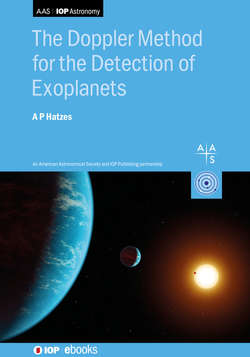Читать книгу The Doppler Method for the Detection of Exoplanets - Professor Artie Hatzes - Страница 40
На сайте Литреса книга снята с продажи.
The Doppler Method for the Detection of Exoplanets A P Hatzes Chapter 3 Factors Influencing the Radial Velocity Measurement
ОглавлениеThe radial velocity (RV) precision that one can achieve depends on many factors: the performance of the spectrograph, the properties of the star, sources of instrumental errors, and finally, stellar variability. Some of these you have control over. For instance, you can take efforts to minimize the systematic errors of your instruments, or you can get more observations of a star in order to “beat down” the noise due to stellar variability. Other factors you cannot control, and these depend on the basic properties of the spectrograph, which are fixed at the design level (e.g., wavelength coverage, resolution) while others depend on the type of star you observe.
So, we can divide these “uncontrollable” factors into two broad categories:
1 Factors due to the instrumental characteristics.These primarily include the spectral resolution, wavelength coverage, and signal-to-noise ratio (S/N) of your spectrum. There are of course other factors that can introduce errors such as instrumental shifts, variations in the spectrograph, improper barycentric corrections, etc. These topics will be covered in subsequent chapters. What we will address here are the basic properties of the spectrograph and the RV precision you would achieve if it worked as a perfect instrument.
2 Factors due to the properties of the star. This is largely dominated by the spectral type of the star (spectral information) and its rotational velocity.
In other words, the only control the researcher has is in the choice of an appropriate target star. Stars can also influence the RV measurement through its intrinsic variability in the form of pulsations or stellar activity. The “stellar noise” aspects will be addressed in Chapters 9 and 10. What we will discuss here are the properties of the star if it were a boring rotating sphere of gas that shows no variability.
Several authors have done detailed studies on the theoretical uncertainties from RV measurements (Beatty & Gaudi 2015; Bouchy et al. 2001; Bottom et al. 2013). It is not our intention to go into a deep mathematical investigation into the uncertainties of RV measurements for two reasons. First, it is more important to have a general feel as to how a spectrograph or a star of given characteristics will influence your RV precision. These will be done through simple numerical simulations. Second, as we shall soon see, systematic instrumental errors and intrinsic stellar variability will introduce errors in your RV measurement that will completely overwhelm the theoretical errors due to photon statistics. You rarely get perfect results.
